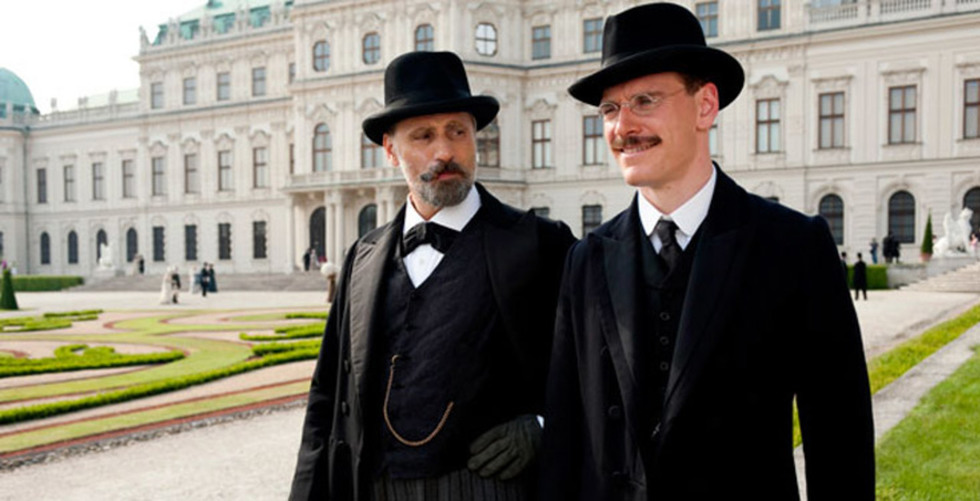
BY ZACHARY WIGON |
A Dangerous Method: From Film to Play and Back Again
Playwright/screenwriter Christopher Hampton talks about Jung and Freud's circuitous journey to the silver screen.


Chamber pieces can often feel a bit stifling in the cinematic realm: with all of the possibilities filmmaking offers, why confine your characters to conversations in a few locations for the whole of a movie? This concern was on my mind as I made my way to a screening of David Cronenberg’s latest, A Dangerous Method. Happily, my concerns were unnecessary. The film, boasting three actors at the top of their game – Cronenberg regular Viggo Mortensen, Keira Knightley, and the now-everywhere Michael Fassbender – is anything but dull. Circling around the great fissure in the early days of psychoanalysis, this film, about the fallout between Freud (Mortensen) and Jung (Fassbender), finds its X-factor in the character of Sabina Spielrein (Knightley), a patient of Jung’s who played an important role in the discord between the two men.
The story behind the film is itself rather complex: A Most Dangerous Method was a non-fiction book by John Kerr about the relationships between the three principals listed above. Christopher Hampton, screenwriter of Dangerous Liaisons, was enlisted to adapt that book into a vehicle for Julia Roberts in the 90s, entitled Sabina. After that film didn’t get off the ground, Hampton refocused the material and turned it into his London play The Talking Cure. After seeing the play, Cronenberg asked Hampton to turn the story back into a screenplay. I had the chance to sit down with Hampton recently to talk about the script’s journey.

Tribeca: I didn’t realize you wrote this film as a script for Julia Roberts’ company, before you turned it into your play. And then of course you adapted your play into this film, for Cronenberg. Can you tell me a bit about the journey the story took?
Christopher Hampton: It’s not really the answer you’d expect, because the stage play and David’s film are much closer to one another than the original script. The original script I wrote was called Sabina, and centered on Sabina Spielrein. It was centered on her point of view, and went through to her death, a kind of biopic. When I reconsidered it for the stage, it dawned on me that the central character had to be Jung. Everything pivots around him, and his is the journey. That made it much more containable, really, the subject matter. I think David’s instinct was to contain it even more, so it becomes this chamber piece about these few people. That’s a much better way to deal with a vast subject like the birth of psychoanalysis than to try to do too much.
Tribeca: What made you realize that Jung should be the pivot point?
Christopher Hampton: Common sense. It just took me a long time. I guess because when they first came to me, I was writing for Julia Roberts, and so I was thinking in terms of a vehicle for her. Afterwards, I thought, this isn’t the best way to deal with this story. As soon as I thought that, it started to fall into place much more logically.
Tribeca: Obviously, you must’ve done quite a lot of work in terms of creating and revising the story, as it went through all these different iterations, that was outside writing the script itself. What is your method like in terms of the work you do before you actually write – outlining and brainstorming and whatnot?
Christopher Hampton: On something like this, it was an enormous long process of going through all the reading and trying to get the facts in order: trying to figure out who was where, when, and why people got angry at certain points. What the subtext of certain letters between Freud and Jung might be. All of that was detective work, in a way. Eventually, a certain kaleidoscopic shape started to appear. I do columns, also – for each of the main characters; I did a column of all the things that I wanted to happen to them. Then you start thinking about the order you want things to happen in, which time periods you’re in, when to cut off. By the time I get to writing, I’m pretty well up to speed. And then I try to write as fast as I can.

Tribeca: So the significant, creative work of the writing is done before you even begin to write, really.
Christopher Hampton: Well, everyone has a different method. Dialogue comes easy to me. That’s the fun bit. What I find fiendishly difficult is shaping a plot. It’s kind of like abstract geometry, just terribly difficult. I drive myself demented trying to figure out what should go where. You make things easy for yourself making a blanket decision to respect the facts. If you invent things on top of everything else, you really do drive yourself crazy. Given that what happened was so interesting, why would you want to embellish? You just want to try to put it in the right shape. The breakthrough of the project, for me, was getting this guy at the hospital in Zurich to get me out Sabina’s case notes, written by Jung. There were fifty pages of typewritten case notes from 1904. It opened the door to the whole subject for me. The whole thing about her physical illness, the physical symptoms, it’s all there in the case notes.
Tribeca: Did you gain an understanding of Jung through those notes as well?
Christopher Hampton: Yeah. He would comment on himself at times, saying, maybe I’m talking too much. This was an experimental treatment, so he was groping in the dark, really. He was improvising: he tried to make himself invisible, because that was his instinct. The word association scene – that was his method. He invented that. All of that was fascinating, just terribly interesting. If you find the right stuff, it writes itself.

Tribeca: You mentioned that dialogue comes easily to you. How do you go about finding a character’s voice? With Jung and Freud, how closely did you try to imitate their own voices?
Christopher Hampton: I think there are two kinds of writers – there are those who have a style, like, let’s say, Harold Pinter – a Harold Pinter play is a Harold Pinter play, everyone speaks the same – or you can do what I do, try to give each character a distinctive voice. That really is a technical thing – you try to give certain characters certain expressions that they use more than once. You try to make sure the other characters have their own turns of phrase. Language is character, in a way. Language use is very indicative of character. With Freud and Jung, you don’t really know what their tone of voice is, you just have the enormous amount of letters they wrote. You have a certain freedom, because the letters are in a different language from the language I’m writing in, so you have a certain flexibility. But those are the principal guidelines to what they might be saying to each other. You just use your intuition after that. You want to humanize them without trivializing them.
Tribeca: Can you expand a bit on how, with them speaking German and your characters speaking in English, there was something liberating in that? You’ve done translation work, right?
Christopher Hampton: Yes, French and German were my subjects at university. One side of me is a translator. The sound of the language is interesting. Freud was a Viennese, but he didn’t sound like one, because he came from a different part of the Austro-Hungarian empire. The thing about Vienna is that everyone has the same accent, from the king to the street-sweeper. Dialect is not a class thing like it is in England. Jung had a Swiss accent, which a very weird, ugly accent, Swiss German. It’s quite hard to understand even if you speak good German. He was always making a conscious effort to speak proper German. He was actually a good linguist – he spoke very good English as well. But all these considerations all swirl around your head.
Also, we decided early on that Sabina would have a Russian accent, because she was Russian. She was a very impressive linguist – she wrote in German and in French. After the period we show in the film, she went and worked in Geneva, which is French-speaking. She could speak those three languages.

Tribeca: The Freud-Jung break is something that’s been explored from a lot of angles. When you decided the script would turn on their falling out, how much did you want to explore the break itself, and how much did you see their break as a metaphor, a way to explore something else, regarding the characters themselves as opposed to the break in the larger psychoanalytic community?
Christopher Hampton: I think the interesting angle to come at it from in this case was: I got the sense that Sabina had a great part to play in their break, that they didn’t just break for scientific reasons, but also because Jung had lied to Freud about her, and there was a shock that Freud felt. Of course, one of the things I wanted to suggest in the film was that if they hadn’t been so vain and childish, psychoanalysis could have developed in a much more integrated way. Sabina, for all her instabilities, was actually much more mature than either of these two men, who, in the end, had to be top dog. The thing degenerated into a pissing contest.
Freud had a recurring pattern of this kind of thing. He had a lot of very close, intimate relationships with his disciples, and then he tended to break from them in a sharp way. Jung was just the most conspicuous of these. Their relationship had the contours of a love affair, because they were so keen on each other to begin with. But they finished up being so absurdly hostile to one another. And out of that hostility came the two major strands of psychoanalytic theory.
A Dangerous Method opens Wednesday, November 23. Find tickets.
Watch the trailer: